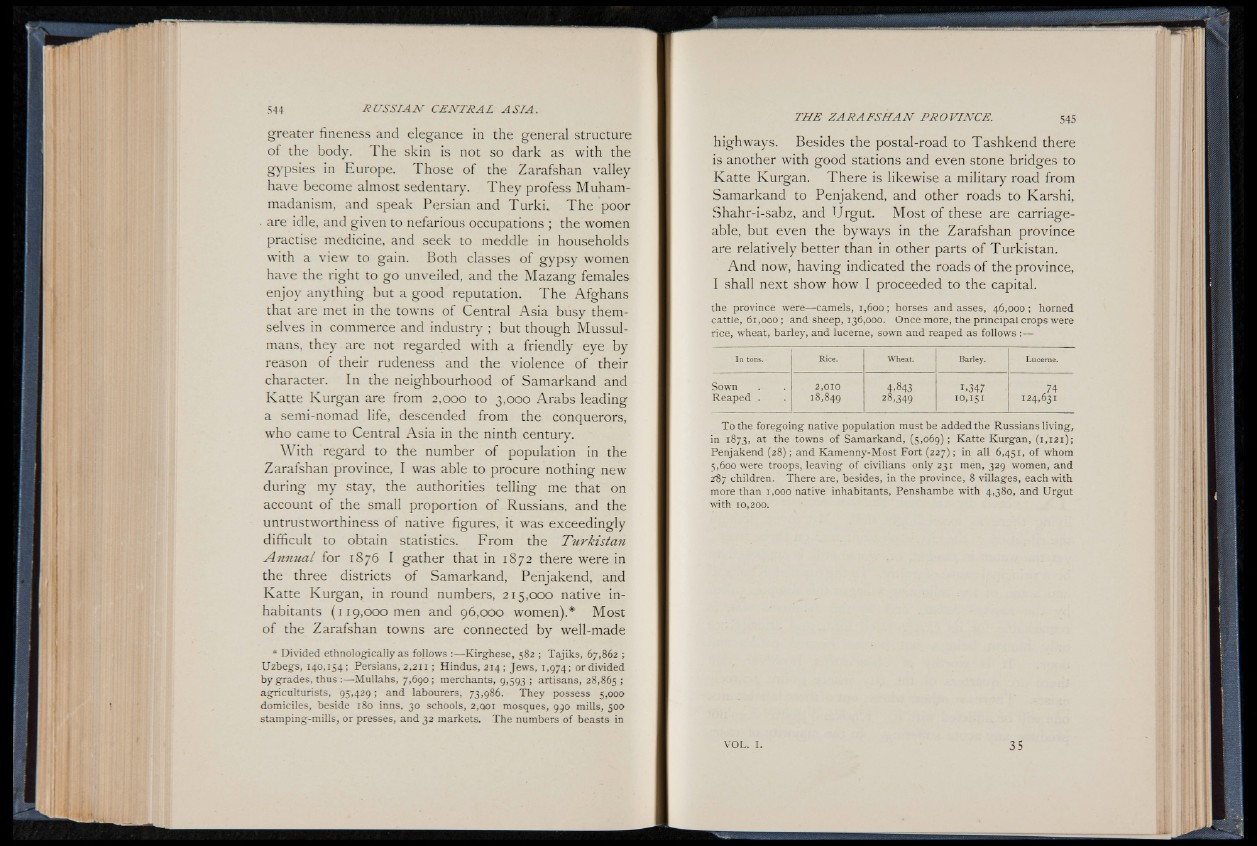
greater fineness and elegance in the general structure
of the body. The skin is not so dark as with the
gypsies in Europe. Those of the Zarafshan valley
have become almost sedentary. They profess Muhammadanism,
and speak Persian and Turki. The poor
are idle, and given to nefarious occupations ; the women
practise medicine, and seek to meddle in households
with a view to gain. Both classes of gypsy women
have the right to go unveiled, and the Mazang females
enjoy anything but a good reputation. The Afghans
that are met in the towns of Central Asia busy themselves
in commerce and industry ; but though Mussulmans,
they are not regarded with a friendly eye by
reason of their rudeness and the violence of their
character. In the neighbourhood of Samarkand and
Katte Kurgan are from 2,000 to 3,000 Arabs leading
a semi-nomad life, descended from the conquerors,
who came to Central Asia in the ninth century.
With regard to the number of population in the
Zarafshan province, I was able to procure nothing new
during my stay, the authorities telling me that on
account of the small proportion of Russians, and the
untrustworthiness of native figures, it was exceedingly
difficult to obtain statistics. From the Turkistan
A n n u a l for 1876 I gather that in 1872 there were in
the three districts of Samarkand, Penjakend, and
Katte Kurgan, in round numbers, 215,000 native inhabitants
(119,000 men and 96,000 women).* Most
of the Zarafshan towns are connected by well-made
* Divided ethnologically as follows :— Kirghese, 582 ; Tajiks, 67,862 ;
Uzbegs, 140,154; Persians, 2 ,211; Hindus, 214; Jews, 1,974; or divided
by grades, th u s:— -Mullahs, 7,690; merchants, 9,593 ; artisans, 28,865 ;
agriculturists, 95,429; and labourers, 73,986. They possess 5,000
domiciles, beside 180 inns, 30 schools, 2,001 mosques, 990 mills, 500
stamping-mills, or presses, and 32 markets. The numbers of beasts in
highways. Besides the postal-road to Tashkend there
is another with good stations and even stone bridges to
Katte Kurgan. There is likewise a military road from
Samarkand to Penjakend, and other roads to Karshi,
Shahr-i-sabz, and Urgut. Most of these are carriageable,
but even the byways in the Zarafshan province
are relatively better than in other parts of Turkistan.
And now, having indicated the roads of the province,
I shall next show how I proceeded to the capital.
the province were— camels, 1,600; horses and asses, 46,000 ; horned
cattle, 61,000; and sheep, 136,000. Once more, the p rincipal crops were
rice, wheat, barley, and lucerne, sown and reaped as follows
In tons. Rice. Wheat. Barley. Lucerne.
Sown
Reaped .
2,010
18,849
4.843
28,349
L 347
10,151 124,6a 37 41
To the foregoing native population must be added the Russians living,
in 1873, at the towns of Samarkand, (5,069); Katte Kurgan, (1,121);
Penjakend (28); and Kamenny-Most Fort (227); in all 6,451, of whom
5,600 were troops, leaving of civilians only 231 men, 329 women, and
Z87 children. There are, besides, in the province, 8 villages, each with
more than 1,000 native inhabitants, Penshambe with 4,380, and Urgut
with 10,200.
V O L . I . 35